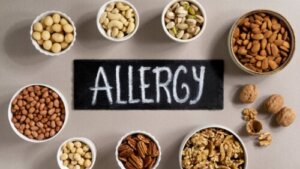6 Myths About Food Allergies in Children

There’s no doubt that food allergies in children represent a topic of focus in global pediatric health, as they impair the quality of life of the child and the family. Despite the interest, some myths about food allergies in children prevail in many families, hindering early diagnosis and proper treatment.
For that reason, we want to talk about some of the misconceptions surrounding children’s food allergies. In this way, it’s possible to achieve a better approach and to know the most common symptoms. Of course, the main recommendation is always to seek guidance from your healthcare professional.

Common myths about food allergies in children
The myths surrounding food allergies go back a long way. They started with the mishandling of the term. Under the term “food allergy”, many disorders related to adverse reactions to food are grouped, without all of them actually being food allergies. Let’s review the most common myths to start debunking them.
1. Any discomfort after eating represents a food allergy
False. One of the most frequent myths regarding food allergies in children is to confuse them with food intolerance. But according to Gupta’s team of researchers, in the journal JAMA Network Open, intolerances are adverse reactions that aren’t immune-mediated, unlike food allergies, which are.
A food allergy is mediated by the immune system, is triggered after exposure to a food, and disappears in its absence. The immune response can be humoral or cellular.
A food intolerance is due to enzyme deficiencies, such as lactose or fructose intolerance, or a pharmacological effect. In other cases, there’s no organic explanation for this phenomenon.
2. Children inherit their parents’ allergies
This isn’t entirely true. An article published in Europe PMC in 2018 suggests that not all allergies are inherited, as environmental factors also play a role in their genesis.
A child can develop a food allergy even if the parents have none. Similarly, a child may not develop an allergy even though a parent has a food allergy.
3. Early exposure to food allergens can cause an allergy
False. Contrary to this myth, current guidelines suggest that early exposure of infants to foods can be beneficial. In this regard, The New England Journal of Medicine shows a study that exposure to peanuts can reduce the incidence of allergies among children at high risk of developing them.
4. Eating “just a little bit” of the food that triggers the allergy does no harm
False. Not giving importance to the manifestation of certain symptoms, however slight they may be after eating a certain food, is a serious mistake. There’s a possibility that in the next contact with the food, the allergic reaction may be greater or life-threatening. The reaction can even be triggered by touching or inhaling it.
5. Food allergies are always serious
Not true. Although food allergies can be dangerous and life-threatening, not all reactions are anaphylactic. In this regard, the guide for the diagnosis and management of food allergies published in the journal Nutrition Research mentions that reactions are very varied and this depends on multiple factors.
6. In the case of a suspected food allergy, the food should be withdrawn
This isn’t the most appropriate form of therapeutic management. If the food is completely withdrawn, this can interfere with the complementary tests and, consequently, with the diagnosis. An allergist is the most appropriate professional to determine whether or not a food should be withdrawn from the diet. In the case of withdrawal, the allergist will also indicate how to carry it out.
At the same time, as parents, we must be prepared to recognize the common symptoms of a food allergy and not confuse them with those of food intolerance. In this way, we help the health professional’s diagnosis.
How does a food allergy manifest itself?
The most frequent reactions of a food allergy are urticaria, i.e., the appearance of itchy hives on the skin, accompanied by swelling. These appear in 70-80% of cases within the first hour after ingesting the food.
These skin manifestations are accompanied by respiratory symptoms such as rhinoconjunctivitis and bronchospasm. There may also be nausea, vomiting, diarrhea, colic, and decreased blood pressure.
Another common symptom is oral allergy syndrome (OAS), which is characterized by itching and tingling sensation in the oral cavity and pharynx. It may also itch around the mouth.

If you notice some symptoms, what should you do?
The first thing to do is to consult your pediatrician, especially if the allergic reaction is active. This will help in the diagnosis. If the pediatrician considers it pertinent, consult an allergy specialist.
To stop the acute reaction, antihistamines are used and, in more severe cases, other drugs indicated by a physician. For example, in cases of anaphylaxis, injectable adrenaline is the treatment of choice.
The food triggering the allergy should be identified and avoided. Also, carefully read the labels of food products and look into the ingredients of the recipes in detail when eating outside the home.
Why is it important to debunk the myths about food allergies in children?
Food allergies represent a health problem that must be addressed by health professionals, from diagnosis and treatment. It’s important not to confuse them with intolerances to certain foods, as the approach is different.
Family beliefs about allergies can confuse and complicate the timely treatment of the disease. Once the professional identifies the food responsible for the allergy, they’ll indicate how to remove it completely from the diet.
There’s no doubt that food allergies in children represent a topic of focus in global pediatric health, as they impair the quality of life of the child and the family. Despite the interest, some myths about food allergies in children prevail in many families, hindering early diagnosis and proper treatment.
For that reason, we want to talk about some of the misconceptions surrounding children’s food allergies. In this way, it’s possible to achieve a better approach and to know the most common symptoms. Of course, the main recommendation is always to seek guidance from your healthcare professional.

Common myths about food allergies in children
The myths surrounding food allergies go back a long way. They started with the mishandling of the term. Under the term “food allergy”, many disorders related to adverse reactions to food are grouped, without all of them actually being food allergies. Let’s review the most common myths to start debunking them.
1. Any discomfort after eating represents a food allergy
False. One of the most frequent myths regarding food allergies in children is to confuse them with food intolerance. But according to Gupta’s team of researchers, in the journal JAMA Network Open, intolerances are adverse reactions that aren’t immune-mediated, unlike food allergies, which are.
A food allergy is mediated by the immune system, is triggered after exposure to a food, and disappears in its absence. The immune response can be humoral or cellular.
A food intolerance is due to enzyme deficiencies, such as lactose or fructose intolerance, or a pharmacological effect. In other cases, there’s no organic explanation for this phenomenon.
2. Children inherit their parents’ allergies
This isn’t entirely true. An article published in Europe PMC in 2018 suggests that not all allergies are inherited, as environmental factors also play a role in their genesis.
A child can develop a food allergy even if the parents have none. Similarly, a child may not develop an allergy even though a parent has a food allergy.
3. Early exposure to food allergens can cause an allergy
False. Contrary to this myth, current guidelines suggest that early exposure of infants to foods can be beneficial. In this regard, The New England Journal of Medicine shows a study that exposure to peanuts can reduce the incidence of allergies among children at high risk of developing them.
4. Eating “just a little bit” of the food that triggers the allergy does no harm
False. Not giving importance to the manifestation of certain symptoms, however slight they may be after eating a certain food, is a serious mistake. There’s a possibility that in the next contact with the food, the allergic reaction may be greater or life-threatening. The reaction can even be triggered by touching or inhaling it.
5. Food allergies are always serious
Not true. Although food allergies can be dangerous and life-threatening, not all reactions are anaphylactic. In this regard, the guide for the diagnosis and management of food allergies published in the journal Nutrition Research mentions that reactions are very varied and this depends on multiple factors.
6. In the case of a suspected food allergy, the food should be withdrawn
This isn’t the most appropriate form of therapeutic management. If the food is completely withdrawn, this can interfere with the complementary tests and, consequently, with the diagnosis. An allergist is the most appropriate professional to determine whether or not a food should be withdrawn from the diet. In the case of withdrawal, the allergist will also indicate how to carry it out.
At the same time, as parents, we must be prepared to recognize the common symptoms of a food allergy and not confuse them with those of food intolerance. In this way, we help the health professional’s diagnosis.
How does a food allergy manifest itself?
The most frequent reactions of a food allergy are urticaria, i.e., the appearance of itchy hives on the skin, accompanied by swelling. These appear in 70-80% of cases within the first hour after ingesting the food.
These skin manifestations are accompanied by respiratory symptoms such as rhinoconjunctivitis and bronchospasm. There may also be nausea, vomiting, diarrhea, colic, and decreased blood pressure.
Another common symptom is oral allergy syndrome (OAS), which is characterized by itching and tingling sensation in the oral cavity and pharynx. It may also itch around the mouth.

If you notice some symptoms, what should you do?
The first thing to do is to consult your pediatrician, especially if the allergic reaction is active. This will help in the diagnosis. If the pediatrician considers it pertinent, consult an allergy specialist.
To stop the acute reaction, antihistamines are used and, in more severe cases, other drugs indicated by a physician. For example, in cases of anaphylaxis, injectable adrenaline is the treatment of choice.
The food triggering the allergy should be identified and avoided. Also, carefully read the labels of food products and look into the ingredients of the recipes in detail when eating outside the home.
Why is it important to debunk the myths about food allergies in children?
Food allergies represent a health problem that must be addressed by health professionals, from diagnosis and treatment. It’s important not to confuse them with intolerances to certain foods, as the approach is different.
Family beliefs about allergies can confuse and complicate the timely treatment of the disease. Once the professional identifies the food responsible for the allergy, they’ll indicate how to remove it completely from the diet.
All cited sources were thoroughly reviewed by our team to ensure their quality, reliability, currency, and validity. The bibliography of this article was considered reliable and of academic or scientific accuracy.
- Boyce, J. A., Assa’ad, A., Burks, A. W., Jones, S. M., Sampson, H. A., Wood, R. A., Plaut, M., Cooper, S. F., Fenton, M. J., Arshad, S. H., Bahna, S. L., Beck, L. A., Byrd-Bredbenner, C., Camargo, C. A., Jr, Eichenfield, L., Furuta, G. T., Hanifin, J. M., Jones, C., Kraft, M., Levy, B. D., … Schwaninger, J. M. (2011). Guidelines for the diagnosis and management of food allergy in the United States: summary of the NIAID-sponsored expert panel report. Nutrition research (New York, N.Y.), 31(1), 61–75. https://doi.org/10.1016/j.nutres.2011.01.001
- Carter, C.A., Frischmeyer-Guerrerio, P.A. (2018). The Genetics of Food Allergy. Curr Allergy Asthma Rep 18, 2, https://doi.org/10.1007/s11882-018-0756-z
- Du Toit, G., Roberts, G., Sayre, P. H., Bahnson, H. T., Radulovic, S., Santos, A. F., Brough, H. A., Phippard, D., Basting, M., Feeney, M., Turcanu, V., Sever, M. L., Gomez Lorenzo, M., Plaut, M., Lack, G., & LEAP Study Team (2015). Randomized trial of peanut consumption in infants at risk for peanut allergy. The New England journal of medicine, 372(9), 803–813. https://doi.org/10.1056/NEJMoa1414850
- Gupta RS, Warren CM, Smith BM, et al. (2019). Prevalence and Severity of Food Allergies Among US Adults. JAMA Netw Open;2(1):e185630. doi:10.1001/jamanetworkopen.2018.5630
This text is provided for informational purposes only and does not replace consultation with a professional. If in doubt, consult your specialist.








